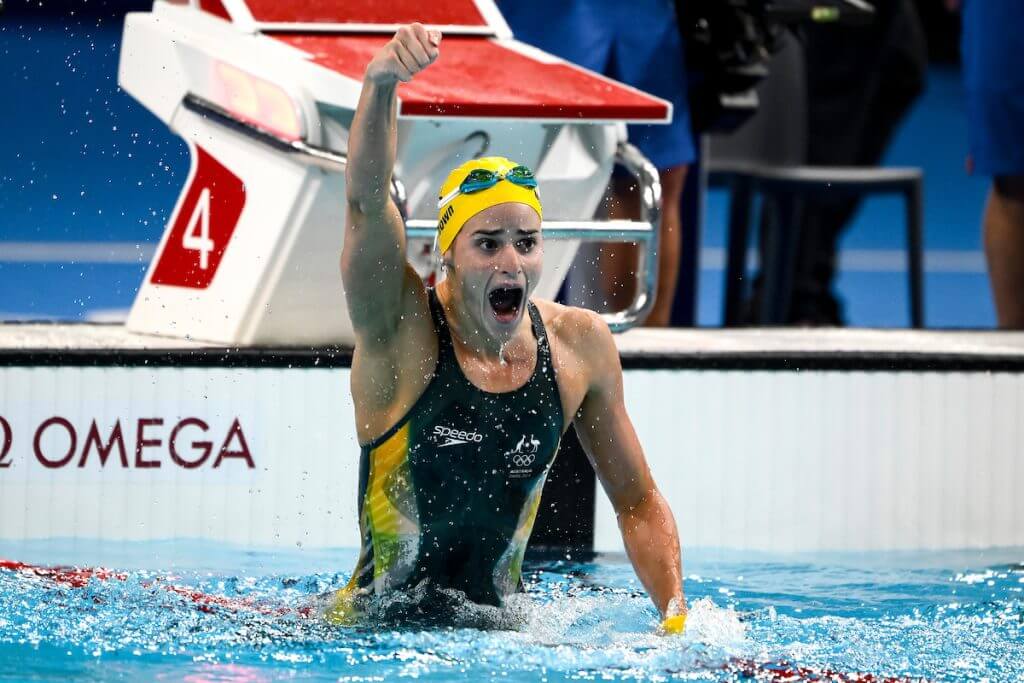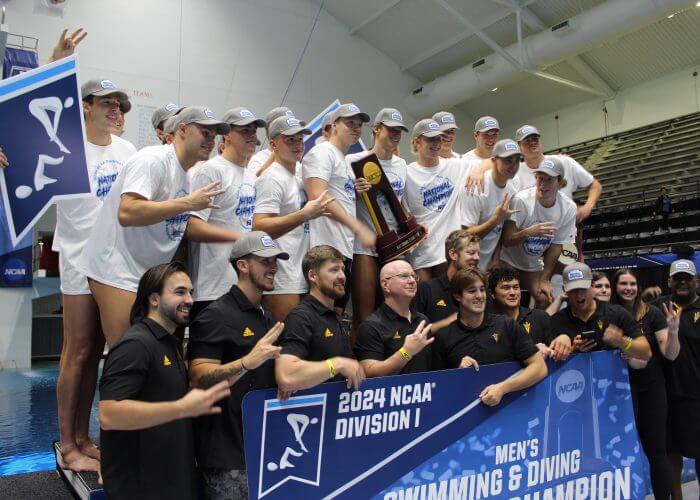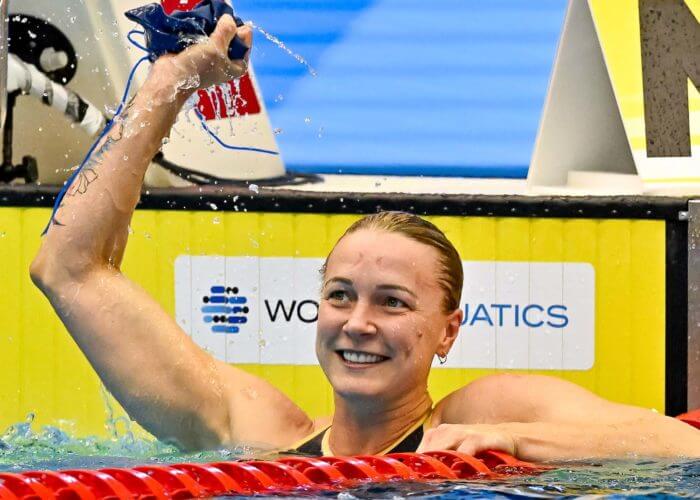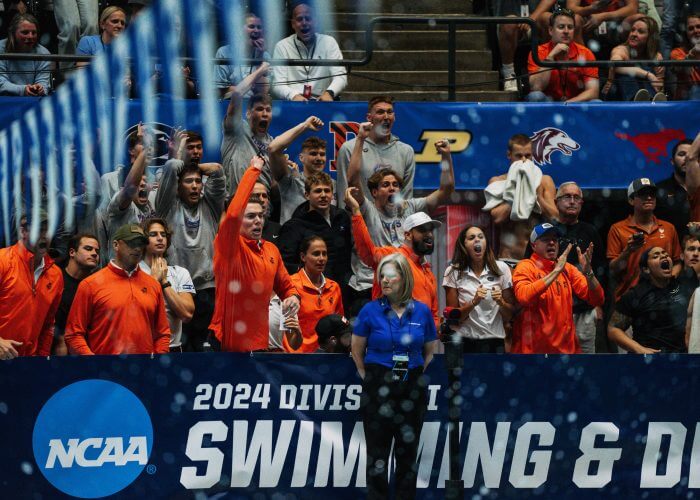How Often Should You Be Swimming Fast? It’s a New World

How Often Should You Be Swimming Fast? It’s a New World
On September 26, five-time Olympic champion Kaylee McKeown blasted a new short course meters 100 backstroke world record. Swimming a 54.56, McKeown undercut the previous record by a significant three tenths of a second. The performance came just under two months after she swept the backstroke events for a second straight Olympic Games.
Two days later, McKeown posted the second-fastest SCM 50 backstroke in history, scaring the record held by Maggie Mac Neil. Unsurprisingly, McKeown is no stranger to swimming fast in season, regularly producing times at or under world record pace throughout the year.
McKeown has set the majority of her world records at meets that would be considered ‘in season.’ She has consistently shown an ability to back up those swims on the world stage, sweeping the backstroke events at the 2023 Worlds, Tokyo Olympics and Paris Olympics.
Twenty years ago, it was the common mentality to train hard through 95% of the year before using that last 5% at an end of season international meet. Nowadays, the game has changed, as varieties of training programs are working for varieties of athletes.
Rise of the Sun Devils

ASU NCAA Champions; Marchand, Bowman, Kulow, Kharun, Kos
On April 1, 2024, it was announced that longtime head coach of the Arizona State Sun Devils Bob Bowman would be vacating his position to take the mantle from retiring Longhorn legend Eddie Reese. This meant that alum and Associate Head Coach Herbie Behm would become the new man in charge at ASU, a position that seemed to be the perfect fit for the blossoming sprint genius.
In 2024, the Sun Devils saw an eight-year culmination of their hard work, winning their first NCAA title in decisive fashion. This title completed a meteoric rise for a team that saw them finish sixth in 2022 and second in 2023.
Not only was the Sun Devils’ win a success for the team, it was a success for college swimming in general. After the team was earmarked for extinction, it took years of work to resurrect it. Taking home the championship trophy at NCAAs showed what was possible for every team in the country. Bowman, Behm, the ASU coaching staff, and nearly a decade’s worth of ASU athletes bought into a dream, tirelessly putting everything into making it a reality.
Building a Legacy in Tempe
Behm’s philosophy is not a secret, as he is one of the most open coaches in the world today. He has spoken often and in depth about swimming fast all year. This idea was part of his philosophy for years before becoming the head coach in Tempe, but only blossomed into existence a few years ago. The hypothesis was simple: Examine the team’s performance in the men’s 200 medley relay in a year where they suited up all season vs. a year they did not. The average drop percentage from training to taper performances sits at about 3%.
After looking at the results, Behm noticed that there wasn’t a substantial difference between the two years’ time drops.
Further evidence contributed to Behm’s ideology. At the 2022 Pac-12s, Sun Devil alum Cody Bybee was in the water preparing for his 50 butterfly portion of the medley relay. In an interview with the Big Friendly Swim Podcast, Behm described how Bybee had spent the entire season perfecting nine dolphin kicks off of his start. However, with the added assistance of a racing suit, Bybee ended up two body lengths behind the ever-important 15 meter mark. The seven dolphin kick last minute change did not seem to hinder the overall swim, as Bybee split a 19.60. With that in mind, Behm theorized that he may have swam an even faster result had he practiced seven kicks all season.
Is It Working?
To date, the answer is a resounding yes. Sun Devil affiliated swimmers, past and present, won 14 medals at the Paris Olympic Games, including the four individual golds by Leon Marchand. As a country, the Republic of Bowman/Behm would have ranked second in the medal tally. In the fall of 2022, there seemed to be a migration of sorts as more than a dozen elite athletes made the change to train in Tempe. Of those athletes, the results weigh heavily in favor of the continuing legacy Behm and Bowman built.
After a tumultuous Olympic quad, Paige Madden qualified in three events for Paris. In her best performance, she swam to an 8:13.00 in the 800 freestyle, ranking her fourth all-time and netting a bronze medal. She had initially made the move to Tempe in September 2023. Simone Manuel is another name that moved to train under Behm and Bowman to kickstart the next phase of her career. She went on to win the 50 freestyle at the Olympic Trials and won two silver medals in Paris. After missing the Olympic Team in 2021, Ryan Held rebounded to come away with a gold medal from the Olympics. In a post-Bowman Sun Devils team, Behm has reloaded considerably with multiple strong recruits and the hiring of Dave Salo, a three-time Olympic coach.
World Class Speed

Photo Courtesy: Andrea / Deepbluemedia / Insidefoto
In 2009, 15-year-old Sarah Sjöström set a world record in the 100 butterfly. A now 31-year-old veteran, the sprint star has had the best year of her career yet. Sjöström came into Paris as the top seed in the 50 freestyle and strong favorite. It was a last minute decision, however, to swim the 100 free – a call that netted the world-record holder her first Olympic title in the event. Sjöström has pared down her event schedule over recent years, sticking mostly to 50s, a move that has paid off greatly. She won the 50s of free and fly at the 2022, 2023, and 2024 Worlds, swimming under or near world record times constantly. In fact, Sjöström has not lost the 50 freestyle or butterfly on a LCM World Championships stage since 2017.
As Sjöström has approached the later stages of her golden career, she has shifted focus to shorter events and made a significant coaching changing in 2022. All of these factors have led to a Sjöström who can seemingly drop historically fast times at the drop of a hat. She is – to date – the only swimmer in history to ever swim under 25.00 in the 50 butterfly, regularly dropping 24-point swims in season. Astonishingly, the five-time Olympian has been under the 25.00 barrier on 22 occasions throughout her career, and owns the top-25 times in history.
Hong Kong’s First Medalist
Siobhan Haughey is another athlete who carries consistent speed to her pedigree. The only Olympic swimming medalist for Hong Kong, Haughey has done it four times, winning silver in the 100/200 free in Tokyo before taking bronze in both in Paris.
Haughey has only gotten better with passing years, and can always be counted on for a fast swim whenever she enters the water. The now 26-year-old owns 24 national records, a testament to her versatility. At the 2023 World Cup stop in Berlin, Haughey blasted a 52.02 100 freestyle time to climb to third in the all-time rankings. A Michigan alum, Haughey is a multi-event threat with the consistency and speed to produce world class performances year round.
The Florida Gators
On the flip side of the ‘swimming fast all year’ ideology sits the University of Florida . Gregg Troy, and now Anthony Nesty, have made a legacy for the team of high yardage workouts that lead to high level results. At the 2020 U.S. Olympic Trials, Florida Gator-affiliated athletes swept the men’s freestyle events. The team has had a stranglehold on the SEC, winning over a decade of men’s titles with the women winning back-to-back titles in 2023 and 2024.
It’s no secret that the Gators train hard, regularly attending in season meets while under heavy training loads. Senior SEC champion Olivia Peoples describes the culture shock of training under Nesty as intense. She describes Nesty as a coach who recognizes potential and succeeds in capitalizing on it. Although high yardage sets are common, they’re never without purpose and focus.

Florida Gators cheering by Emily Cameron
Nesty is an Olympic champion himself, winning gold in the 100 butterfly in 1988. His successes as a coach would see him named as the head coach of the U.S. men for the Paris Olympics.
One cannot mention the Florida Gators without mentioning Caeleb Dressel. Dressel became the first man in history in 2018 to swim under 18.00 in the 50 freestyle. Additionally, he also broke 43 in the 100 butterfly (just a year after Tom Shields broke 44). Oh, and he also broke 40.00 in the 100 freestyle. After all that, he won five gold medals in Tokyo three years later.
The Florida Gators in many ways represent the opposite end of the spectrum compared to the ideology that has led ASU to great success. And yet both teams remain at the forefront of the national swimming spotlight.
What Works Best?
There is no universal ideology of what will work for all swimmers. Swimming as a sport contains a multitude of variations in training needs. A world class 50 freestyler will usually not be a world class 200 breaststroker, unless your name is Kate Douglass. However, in recent years, the concepts around how or when to swim fast have radically changed. Athletes like Cameron McEvoy are changing the game, opening up new heights for swimming overall.
The varying distances and strokes in our sport require training styles that are tailored to the individual. Above all, the decision ultimately lies with coaches who work with their athletes to cater a workout that leads to the greatest success.




The article never clarifies what “swimming fast all year” means. In practice, swimming hard despite a meet coming up? In meets, meaning that practice is easier going into it? Or are they simply talking about USRPT?
This is a fair point actually that I wish I had clarified more on in hindsight. I meant like suiting up all year and dropping fast in season times. Thanks for reading!